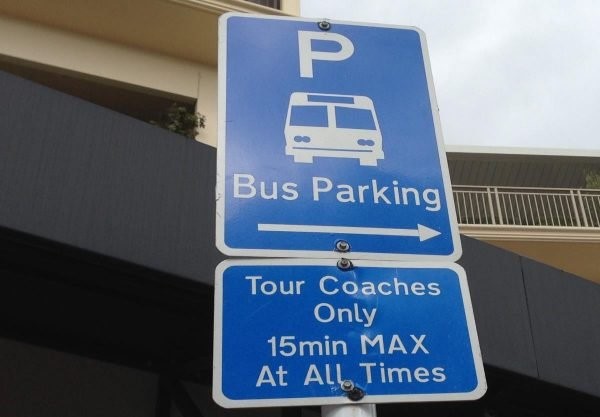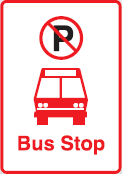On-street layovers on public roads should have appropriate signs and markings to ensure that the parking restrictions are legally enforceable. This is imperative to ensuring the layover can function as intended.
We generally recommend that layovers, especially those serving multiple bus routes and/or bus drivers to take meal breaks, be signed and marked as bus parking rather than as a bus stop. This is because under the relevant legislation (Road User Rule 2004), there are restrictions on parking at bus stops as bus stops are intended for loading and unloading of passengers. However, as discussed in the Locating bus layovers section there may be instances when it will be most pragmatic and suitable for short layover to occur in co-located bus stops.
When deciding on an appropriate sign, think synergistically about how the allocated space might be able to help serve other, additional, demands such as tour coach or charter bus parking. If sharing space would be okay from an operational perspective this could potentially support outcomes like, for example, less aggregate kerbside space needed or better integrated customer journeys between inter-regional services and local public transport networks.

Example of a bus layover space with the recommended R6-53 bus parking sign. Source: Lorelei Schmitt

Example of coach parking signage on street.
In terms of off-street layover locations, access to and from the site can be controlled by various means such as barriers, signage or markings at the entrance or exit. The asset owner may also require signs within the site on a case-by-case basis.
Parking signs need to be used to establish an on-street layover space(s) in which the bus may be parked. These signs will need to illustrate the vehicle type(s) that may park (e.g. bus) and if appropriate any time limit on the length of time for parking.
Signs that should be used for layover locations as described by the Traffic Control Devices Manual and are shown in the table below.
|
Type of restriction |
TCD Rule sign reference |
Use |
Sign examples |
|
Loading zone (bus stop) no parking |
R6-71 |
To establish a bus stop and to indicate where no vehicle, other than a bus, may park, stop or stand provided the driver remains in attendance |
 |
|
Parking reserved for described vehicle classes |
R6-53 R6-53.2 |
To establish a bus layover space(s) and to indicate the permitted types of vehicle parking (and the extent of any parking time limit) |
|
Road markings for on-street layover spaces must be yellow and used in conjunction with the appropriate parking signs.
When parallel to the kerb or roadway edge, markings must be indicated by the provision of:
When marked at an angle to the kerb or roadway edge, markings must be indicated by continuous yellow lines on either side of the bus layover at the appropriate angle to the kerb or road edge.
Once markings are laid they should be captured in relevant maintenance contracts that the council has.
Specifications for signs and markings are described in the Traffic Control Devices Manual.